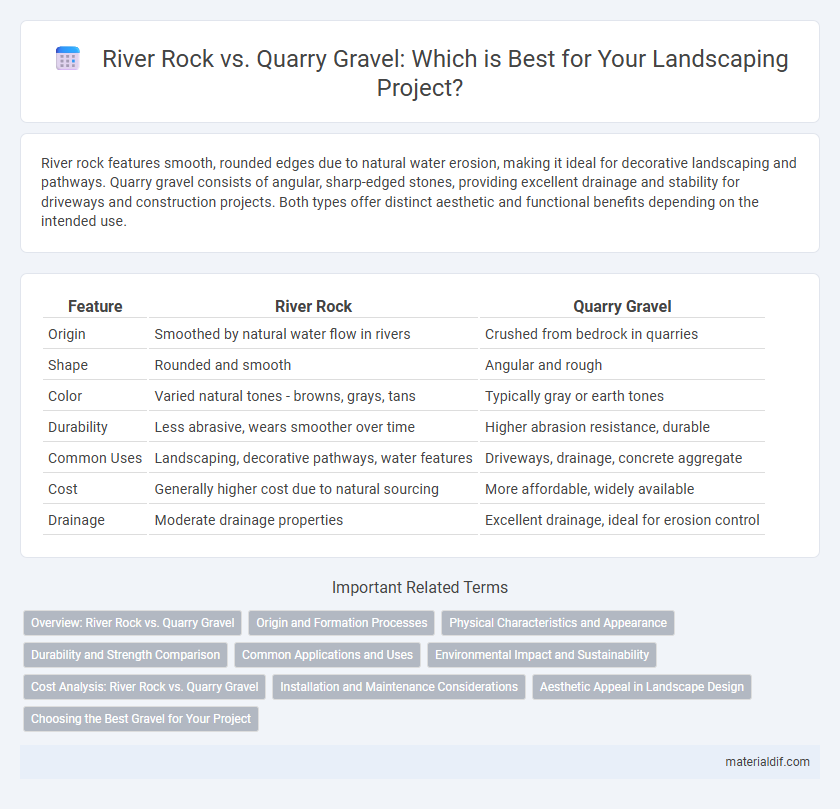River rock features smooth, rounded edges due to natural water erosion, making it ideal for decorative landscaping and pathways. Quarry gravel consists of angular, sharp-edged stones, providing excellent drainage and stability for driveways and construction projects. Both types offer distinct aesthetic and functional benefits depending on the intended use.
Table of Comparison
| Feature | River Rock | Quarry Gravel |
|---|---|---|
| Origin | Smoothed by natural water flow in rivers | Crushed from bedrock in quarries |
| Shape | Rounded and smooth | Angular and rough |
| Color | Varied natural tones - browns, grays, tans | Typically gray or earth tones |
| Durability | Less abrasive, wears smoother over time | Higher abrasion resistance, durable |
| Common Uses | Landscaping, decorative pathways, water features | Driveways, drainage, concrete aggregate |
| Cost | Generally higher cost due to natural sourcing | More affordable, widely available |
| Drainage | Moderate drainage properties | Excellent drainage, ideal for erosion control |
Overview: River Rock vs. Quarry Gravel
River rock features smooth, rounded stones formed by natural water erosion, making it ideal for decorative landscaping and water features due to its aesthetic appeal and texture. Quarry gravel consists of angular, crushed stones extracted from quarries, providing superior compaction and drainage properties, commonly used in construction, driveways, and erosion control. Both materials vary in durability, cost, and application suitability, with river rock favored for ornamental purposes and quarry gravel preferred for structural support and stability.
Origin and Formation Processes
River rock forms naturally through the erosion and smooth sediment transport in riverbeds over thousands of years, resulting in rounded edges and polished surfaces. Quarry gravel is produced by mechanically crushing larger stones in quarries, leading to angular and rough-textured fragments. The natural water action influences river rock's shape and composition, while quarry gravel reflects the mineral makeup of the parent rock extracted.
Physical Characteristics and Appearance
River rock features rounded, smooth surfaces and a variety of natural colors due to prolonged water erosion, making it ideal for decorative landscaping. Quarry gravel consists of angular, rough-textured stones with sharp edges, typically uniform in size and color because it is mechanically crushed from larger rocks. The distinct physical characteristics influence their applications, with river rock preferred for aesthetic appeal and quarry gravel favored for structural uses.
Durability and Strength Comparison
River rock, characterized by its smooth, rounded edges formed through natural water erosion, offers moderate durability ideal for landscaping and drainage applications. Quarry gravel, with its angular, jagged particles extracted directly from rock quarries, provides superior strength and compaction, making it more suitable for heavy-duty construction and foundation projects. The crushed nature of quarry gravel increases interlocking capabilities, resulting in enhanced stability and load-bearing capacity compared to the naturally smoothed river rock.
Common Applications and Uses
River rock is commonly used for landscaping projects, garden pathways, and decorative water features due to its smooth texture and natural rounded shape that enhances aesthetic appeal. Quarry gravel, characterized by its angular edges and rough texture, is preferred for construction applications such as driveways, concrete mixing, and drainage systems because of its superior compaction and stability. Both materials serve essential roles in outdoor design and infrastructure but are selected based on specific functional and visual requirements.
Environmental Impact and Sustainability
River rock, naturally smoothed by water flow, has a lower environmental impact due to minimal processing and reduced energy consumption. Quarry gravel, extracted through blasting and crushing, often results in habitat disruption and higher carbon emissions. Choosing river rock supports sustainability by preserving ecosystems and reducing the carbon footprint associated with material production.
Cost Analysis: River Rock vs. Quarry Gravel
River rock typically costs between $0.50 to $2.00 per square foot, reflecting its natural smooth texture and aesthetic appeal, whereas quarry gravel ranges from $0.30 to $1.00 per square foot, offering a more budget-friendly option for large-scale projects. Transportation and processing costs contribute significantly to the price difference, as river rock often requires more careful handling and sorting. Choosing quarry gravel can reduce overall landscaping expenses without compromising durability, making it ideal for practical applications like drainage and driveways.
Installation and Maintenance Considerations
River rock offers smooth, rounded edges that simplify installation by reducing the need for extensive leveling, while quarry gravel's angular fragments interlock better, providing enhanced stability for pathways and driveways. River rock requires less frequent maintenance due to its natural resistance to shifting, but quarry gravel demands occasional raking and replenishing to manage displacement and compaction. Choosing between river rock and quarry gravel depends on project-specific needs for ease of installation and long-term upkeep.
Aesthetic Appeal in Landscape Design
River rock offers smooth, rounded edges and natural color variations that enhance aesthetic appeal in landscape design, creating a more organic and tranquil environment. Quarry gravel features sharper angles and a uniform texture, providing a rugged, modern look suitable for minimalist or industrial themes. Selecting between river rock and quarry gravel depends on desired visual texture and the style coherence of the outdoor space.
Choosing the Best Gravel for Your Project
River rock features smooth, rounded stones ideal for decorative landscaping and drainage projects, while quarry gravel consists of sharp, angular rocks better suited for construction and heavy-duty applications due to superior compaction. Choosing the best gravel depends on the project's functional requirements, such as aesthetic appeal, drainage capability, and load-bearing capacity. For pathways and garden beds, river rock provides a visually pleasing, slip-resistant surface, whereas quarry gravel enhances structural stability in driveways and foundation bases.
River Rock vs Quarry Gravel Infographic

 materialdif.com
materialdif.com